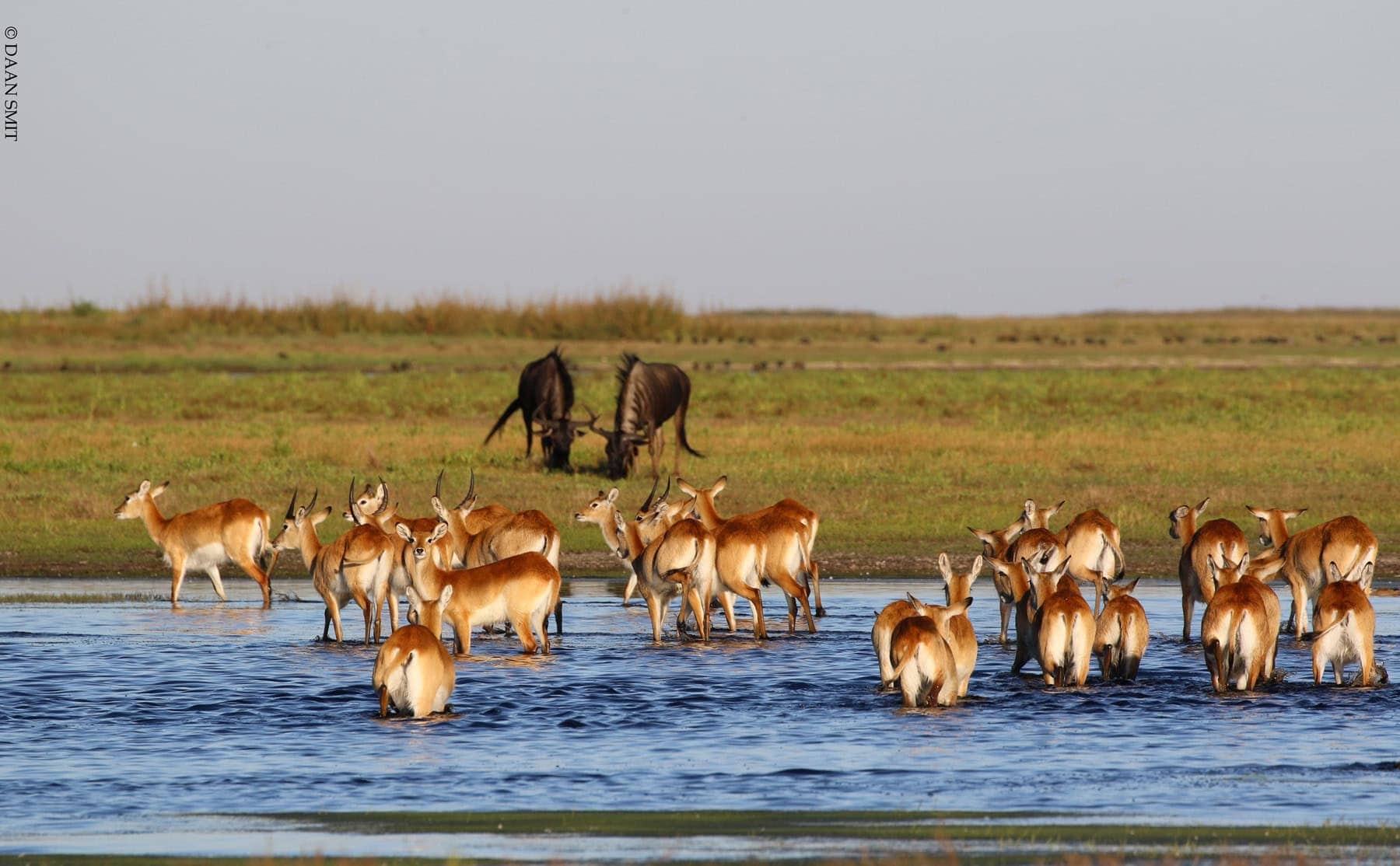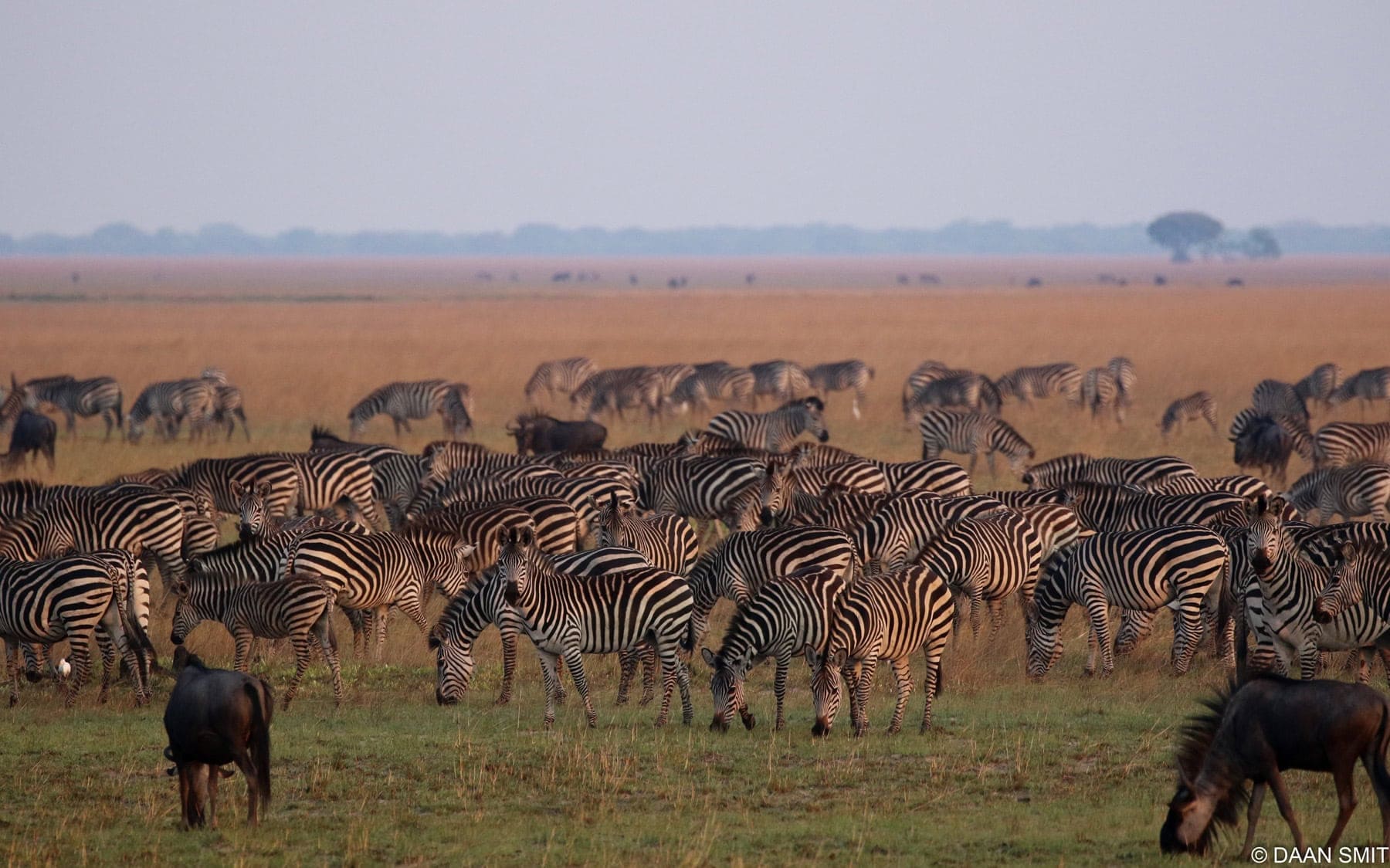In an open-air safari vehicle, you and your guide are taking on the open plains during your African safari. You’re on your way to see one of the most incredible sights available while on a Zambia wildlife safari: massive herds of wildebeest moving in unison with a single goal in mind. Suddenly, you’re there – just in front of the vehicle, there are swarms of wildebeest for as far as the eye can see. The wildebeest migration in Zambia is a safari experience unlike any other – even the Great Migration. Here’s why.
When thinking about migration safaris in Africa, so often it’s the Great Migration that comes to mind. Across the Serengeti and into the Masai Mara, millions of wildebeest create a dramatic spectacle as they cross rivers and dodge predators. However, there’s another migration that you, as a safari traveller, should consider in southern Africa.
What is the Migration in Zambia Between November and December?

The first rains of the wet season in Zambia set into motion the second largest wildebeest migration in Africa. As the rain begins to quench the thirst of the land after the dry months, tens of thousands of wildebeest begin moving north across seemingly endless plains, with the single mind of finding fertile grasslands for grazing and calving.
Where is the Wildebeest Migration in Zambia?

This natural event – a highlight of the Zambia safari calendar – occurs in Liuwa Plain National Park, an often overlooked destination on the safari circuit. One of the best parts about going on a green season safari in Liuwa is that the park doesn’t see a lot of travellers. This means you’ll get to have the experience of watching the migration sans crowds, in vast contrast to the tens of thousands of people who go on a Great Migration safari in Tanzania or Kenya each year.
Liuwa Plain National Park is bordered by two rivers: the Luabimba River and the Luanginga River. In between, there is a vast grassland that rivals the majesty of the Serengeti to explore and is populated with far more than just migrating wildebeest.
What Other Wildlife Can Be Seen During This Experience?

Among the vast herds of wildebeest that can be seen gathering on the southern plains are zebras, tsessebe antelopes, and buffaloes. As the herds begin moving northward, across plains dotted with lilies, predators are on the prowl…
Hyenas are abundant and can be seen stalking the watery plains for their next meal. During game drives, you may also spot the dappled coats of cheetahs as they traverse the grasslands, never far behind the wildebeest herds.
Liuwa Plain National Park is an incredible conservation success story. In the early 2000s, just one lioness remained in the park after rampant poaching decimated the prides here. Affectionately known as Lady Liuwa, this lioness was joined by Sepo, and the two became inseparable. Thanks to further conservation efforts, Sepo had cubs and Lady Liuwa helped raise them. The legacy of the once lone lioness still reverberates across the park, and it’s encouraging to see that Liuwa is now home to a growing pride.
Over 357 bird species can be seen in the park. Excellent birdwatching opportunities coincide with the wildebeest migration, as migrant birds fly into the park, including large flocks of black-winged pratincoles. Along the waterways, keep an eye out for slaty egrets, saddle-billed storks, and wattled cranes (of which Liuwa boasts Africa’s largest population).
Where to Stay During the Zambia Wildebeest Migration

Located in upper Zambezi floodplains and perched among woodlands is King Lewanika Lodge, a beacon of luxury in one of the most remote safari destinations in Africa. Comprising just six tents and only accommodating a maximum of 15 guests, this lodge is a haven for those who want to escape the safari crowds.
Seeing the incredible wildebeest herds during November and December is just one of the safari activities on offer at King Lewanika. Imagine waking up as the sun begins to warm up the expansive plains in front of your tent. You head out to your private, spacious verandah to simply enjoy the view with a cup of coffee or roll out your yoga mat for a few sun salutations.
Game drives are taken to another level thanks to King Lewanika’s game viewing vehicles. The fleet is equipped to provide guests with a unique, elevated perspective of the grasslands from their rooftop vista seats. Each vehicle features photography bean bags, USB charging points, and LED lighting to ensure guests have the best luxury safari Zambia has to offer.

Sustainability and furthering the conservation story of Liuwa is at the heart of King Lewanika’s operations. This can be seen in the solar farm that powers the whole lodge with renewable solar energy as well as the state-of-the-art water filtration system that forgoes the need for plastic water bottles.
The Magical Liuwa Plain safari with Discover Africa will take you to Liuwa Plain National Park to explore this wonderland, with your base being King Lewanika. After traversing the plains, you’ll be delighted by the variety of special experiences available, from extraordinary dining experiences to enchanting bush cinemas and drive-thru ice cream stops.
If the thought of witnessing a dramatic wildebeest migration has always appealed to you, but the idea of sharing that experience with throngs of tourists doesn’t, then the wildebeest migration in Zambia is the answer. Imagine the excitement of watching tens of thousands of wildebeest thundering across the plains with predators hot on their heels. Coupled with the luxurious and sustainable haven of King Lewanika Lodge, a safari in Liuwa promises an intimate and unforgettable connection with the wild heart of Africa.
Author: Paula Rabeling
Published: 24 April 2025
Last Update: 24 April 2025